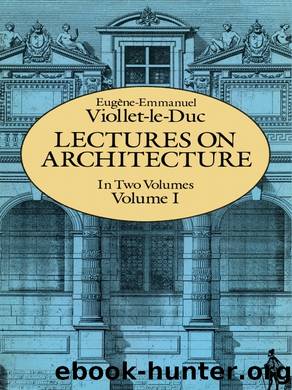Lectures on Architecture, Volume I by Viollet-le-Duc Eugene-Emmanuel;

Author:Viollet-le-Duc, Eugene-Emmanuel;
Language: eng
Format: epub
ISBN: 1900711
Publisher: Dover Publications
Published: 2012-10-10T16:00:00+00:00
LECTURE VII.
THE PRINCIPLES OF WESTERN ARCHITECTURE IN THE MIDDLE AGES.
THE Architecture of the Ancients was long studied without any account being taken of the effects produced by the colouring of the form; whether this colouring was produced by mosaic, marble veneering, or painting on stucco. The Orientals and Greeks, and even the Romans rejected the principle that the naked material of which an edifice was constructed should remain visible. The Greeks coloured white marble when they employed that beautiful material. However slight that colouring may have been (though everything leads us to suppose that it was on the contrary strong and vivid), its result was none the less that of concealing the real material under a kind of tapestry independent of that material. I am not one of those who would allow that the Greeks could have adopted a false principle in the execution of works of art; and if we find them adopting modes of procedure that are apparently strange, and to which we find it difficult to accustom our eyes, I should rather believe in the imperfection of our senses than in an error on the part of these masters in art.
It is now some time since archaeologists and artists made clear, even to the most incredulous, that all the Greek monuments had a colouring both outside and inside, laid on a thin coat of stucco when the stone was of a coarse grain, and on the smooth surface of the marble itself, when the building was of that material. This indisputable fact leads us to suppose that the Greeks did not regard the form alone as sufficient for architectural effect, but considered that this form should be completed, aided or modified by a combination of various colours. No lengthened experience in matters of art is needed to show what an influence colour has on form, and even on proportions : if, for example, we were to colour black the metopes and the wall of the cella of a Greek temple, we should obtain an effect quite different from that which would result from leaving these metopes and the wall white, and covering the cornice, the triglyphs, the architrave, and columns black (fig. 1), all the real dimensions and proportions remaining the same. The result of the first method of colouring would be to give breadth to the order, and importance to the architrave, the triglyphs, and the cornice ; that of the second, indicated at B, would be to make the columns appear more slender and lofty, while the entablature would lose in importance. Colouring therefore greatly influenced the effect produced by architecture ; and in the present day we cannot form a correct. judgment of the ancient Greek buildings without taking the colouring into account. An order that seems to us heavy might have appeared slender ; another whose proportions seem delicate would present a firm and solid appearance.
Download
This site does not store any files on its server. We only index and link to content provided by other sites. Please contact the content providers to delete copyright contents if any and email us, we'll remove relevant links or contents immediately.
Ancient Worlds by Michael Scott(2622)
Savage Harvest by Carl Hoffman(1912)
The Monuments Men by Robert M. Edsel(1738)
Cain by Jose Saramago(1493)
The Apogee - Byzantium 02 by John Julius Norwich(1410)
A History of the World in 100 Objects by MacGregor Neil(1308)
The O. Henry Prize Stories 2014 by Laura Furman(1208)
The Unfinished Palazzo by Judith Mackrell(1141)
The Swerve by Greenblatt Stephen(1120)
The Lost Secrets of Maya Technology by James A. O'Kon(1088)
50 Art Ideas You Really Need to Know by Susie Hodge(1053)
Joan Miró by Joan Miró(1028)
4 3 2 1 by Paul Auster(1023)
Cain by Saramago José(1015)
A Piece of the World by Christina Baker Kline(991)
Heretics and Heroes by Thomas Cahill(984)
The Book of Ruby(966)
Raising Hell: A Concise History of the Black Arts and Those Who Dared to Practice Them by Robert Masello(951)
1484244826 by Unknown(900)
